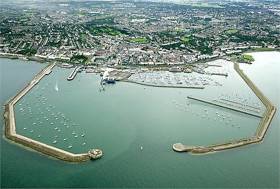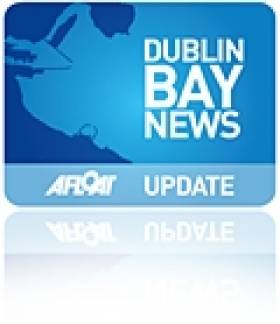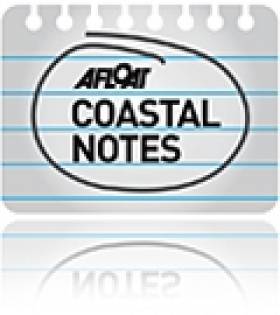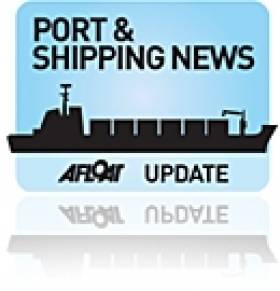Displaying items by tag: Dun Laoghaire Harbour News
Minister Launches Dun Laoghaire Harbour Bicentenary Steering Group
#Bicentenary - Minister for Jobs & Innovation Mary Mitchell O'Connor today became Patron of the Dun Laoghaire Harbour Bicentenary programme.
Convening in the historic Harbour Lodge in Dun Laoghaire, the Minister met members of the Steering Group, which includes the Pavilion Theatre, DLR County Council, the RNLI, the Coal Harbour Users Group, The National Maritime Museum, Dalkey Heritage Centre, a representative of the 4 Yacht Clubs, the Dun Laoghaire Harbour Company and Dun Laoghaire Business Improvement District (BID).
The Bicentenary Steering Group met to discuss a series of initiatives to commemorate and celebrate the 200 year history of this historic harbour.
May 31st 1817 saw the laying of the first stone in the creation of one of the world’s finest man-made harbours, originally named as "The Royal Harbour of King George IV at Kingstown"
Gerry Dunne, CEO of Dun Laoghaire Harbour Company said " this is an incredibly exciting initiative , of national and international significance. We will be engaging with members of the Irish Diaspora all over the world, so that we can gather relevant stories and memorabilia, and create a legacy both online and physical, a legacy which this special place fully deserves"
#Transfer - Minister for Transport has said in the Seanad the transfer of governance of Dún Laoghaire Harbour Company to the local council is imminent, writes The Irish Times.
Minister Shane Ross said he understood the company and Dún Laoghaire-Rathdown County Council had established transitional teams which were working on the practical issues associated with the transfer. (See: Regional Ports Transfer)
He said officials from his department had met both sides on a number of occasions to assist in the process. “I have also met with many local groups,’’ he added.
Mr Ross said the company faced a challenging financial and operating environment as it moved from commercial shipping activities towards a different operating model, with the focus on marine leisure and marine-related tourism.
Stena Line’s departure from Dún Laoghaire Harbour added to the future challenges to the company. “The financial impact on the port is significant and it is very clear that the company faces a very different operating environment than it faced in the past,’’ he said.
For more on the commercial future of the harbour, click here
As previously reported on Afloat.ie, a Public Meeting regarding the proposed giant cruise liner berth is scheduled today, Thursday 27 October at 7pm in the Royal Marine Hotel. Speakers including Richard Boyd Barrett TD and Cllr Melissa Halpin will outline the two main options for the Government as the SOS movement sees it.
Kish Lighthouse's Golden Anniversary Reflects Car-Ferry Era But Not to 'Sea' HSS Service
#Kish50HSSgone - An exhibition in Dun Laoghaire celebrating the Kish Lighthouse 50th anniversary on Dublin Bay is currently on display, however the Stena Line HSS service to Holyhead which was withdrawn only last year has been outlived by the iconic lighthouse, writes Jehan Ashmore.
The venue for the Kish Lighthouse exhibition (until 21 November) is at the National Maritime Museum of Ireland located almost directly opposite of the present day iconic landmark of the LexIcon Library that overlooks the East Pier.
In addition the LexIcon as a new civic building has commanding sweeping views of the harbour, Dublin Bay and to the Baily Lighthouse on Howth Peninsula. Further offshore on the horizon stands the Kish Lighthouse all 31 metres high. The lighthouse replaced a lightship that likewise of the new lighthouse was manned until automated in 1992. The current character of the light exhibited has a range of 22 nautical miles.
Back onshore, Ireland’s most popular pedestrian pier, the East Pier is featured as part of the historic Pathé news footage (see above) as the Kish Lighthouse is ‘floated’ out of Dun Loghaire harbour from where the uniquely constructed structure was built. The design for the Commissioners of Irish Lights was of that of a concentric circular concrete tower based from similar yet smaller models in Sweden, and was towed from the harbour some seven nautical miles offshore to the Kish Bank.
The departing lighthouse structure under tow from the harbour even now looks futuristic and likewise to when I recall witnessing the first arrival of the Swedish owned yet Finnish built HSS Stena Explorer. She made her debut just over three decades later after the lighthouse began service. The fast-ferry was sold this Autumn and is currently under tow while bound for a new career in Turkey, which as previously reported leads to query her future role? given that her owners operate 'floating' generating powerships!
Returning to the Pathé news reel, (some 30 seconds in) on the left side of the screen can be seen white buildings on the East Pier. They belonged to the harbour's first albeit temporary car-ferry terminal (another controversary! of the time). The facility was completed a year before the installation of the Kish Lighthouse in 1965. The terminal's appearance comprised of metal constructed halls more akin to factory warehouses! In fact the terminal building extended almost the entire width of the East Pier!... click for Photo.
It was during that year's summer that the introduction of the first roll-on roll-off 'carferry' on the Dun Laoghaire-Holyhead route begin service with a resounding success. The traditional 'mail-boats' maintained a year-round service based out of the Carlisle Pier. From there cars were crane-hoisted on board for many years, however tourism interests lobbied for a carferry service from the early 1960's.
This led to Dun Laoghaire Harbour’s first ferry terminal with a ro-ro linkspan that protruded from the East Pier Jetty. The facility was inaugurated by the Irish-Walsh route’s first purpose built car-ferry, the unimaginatively named but pioneering Holyhead Ferry 1. The new carferry was delayed entering service from her builders and instread the English Channel based Normannia opened the seasonal 'car' service.
Normannia originally a passenger-ferry had been converted to carry cars was eventually replaced by Holyhead Ferry 1 that season. The Scottish built stern-only carferry loaded and offloaded vehicles while berthed at the East Pier linkspan, though this structure located off the jetty has long since been demolished.
The berth at this East Pier Jetty until recent years has long been associated with the customary visits of Irish Naval Service patrol ships, however this part of the pier is to undergo a reincarnation. That been as previously reported on Afloat, the Dun Laoghaire Harbour Company’s ‘Urban Beach’, a €2.5 million heated floating swimming pool inspired by the 'Badeschiff' in Berlin.
The project will involve a converted river barge at the East Pier following last year’s planning permission granted by An Bord Pleanála. The planning authority is to make a decision (see SOS protest) following oral hearings into DLHC’s single €18m cruise-berth in January 2016. DLHC cited should a suitable ferry operator be found it would not be until 2016 and that the Ireland-Wales service like the HSS service would be run on a season-only basis.
Seven operators responded earlier this year following an invite from DLHC for those expressing an interest to operate such a service, however this would not involve the idle Stena HSS berth at the terminal on St. Michaels Wharf. The same site dates back to the original purpose-built terminal dating from 1969 that replaced the facility on the East Pier.
Dun Laoghaire Harbour's only remaining ferry berth (last used several years ago by a smaller Stena 'Lynx' fast -ferry) is also located on the Wharf. This linkspan facility adapted from a conventional carferry berth was also in use by Stena tonnage until the early 1990's.
The future role of the St. Michaels Wharf ferry terminal is now centre stage given DLHC's proposed cruise-berth is to connect to the terminal's former HSS vehicle marshalling bays where cruise passengers would use awaiting coaches and taxi's. At the same time, there are plans at the same site put forward by the Dun Laoghaire Combined Clubs for a National Watersports Centre.
Remnants of another ro-ro linkspan on Carlisle Pier still visible, ceased use in 1996 when Stena Adventurer (ex. Stena Hibernia / St. Columba of Sealink British Rail ) was replaced by the Stena HSS. The revolutionary fast-ferry was also a pioneering venture on the route for almost two decades.
The old ro-ro's concrete berth's structure with operations hut can be seen from the Royal St. George Yacht Club albeit the corresponding linkspan is gone should you peer through the railings that bound the pier's car-park.
This part of the Carlisle Pier is the closest the public can access when small sized cruiseships have berthed since the trade returned to the harbour in recent years. While larger deeper draft cruiseships anchor offshore, notably the last caller of this season was the newbuild Mein Schiff 4.
Stena's Planning Application to Remove Dun Laoghaire HSS Berth Declared Invalid
#HSSberthRemoval - A planning application from Stena Line to remove its idle HSS fast-ferry berth in Dun Laoghaire Harbour, has been declared invalid due to failing to comply with articles in the planning procedures, writes Jehan Ashmore.
Dun Laoghaire-Rathdown County Council (DLRCoCo) has deemed the application submitted earlier this month to be invalid due to a failure to fully furnish documents in accordance with the Planning & Development Regulations 2001.
Among the articles not complied by Stena Line in its application to DLRCoCo, is the requirment that an applicant shall within the period of two weeks before the making of a planning application give notice of the intention to publish the application in a newspaper.
It transpires that the planning authority only received the application from Stena but this was submitted late, been one day beyond the required fortnight to be recognised valid.
Stena Line's head office in Holyhead (responsible that is for its Irish Sea south operations) has made no new resubmission to DLRCoCo to date.
The Stena HSS berth has remained redundant since the ferry operator withdrew the fast-ferry craft more than one-year ago in September 2014. The ferry firm decided to concentrate all operations in Dublin Port.
Prior to the transfer to the capital, Dublin Port has already been a customer of Stena since 1995, one year before the HSS Stena Explorer took up service on the Dun Laoghaire route. The former fast-ferry remains laid-up in the Welsh port, while two ferries operate the Dublin-Holyhead route which takes 3 hour 30 minute to complete the core central Irish Sea route.
As previously reported on Afloat.ie, Stena want to remove this year the specialist custom-built HSS craft berth linkspan, associated steel-supporting pier dolphins and concrete structures at St. Michael’s Pier. To give an indication, the outermost dolphin extends from the pierhead and is somewhat a little further into the harbour to that parrallel of the East Pier Bandstand.
The application would also involve work to dismantle where the 19,638 tonnes fast-ferry used to dock next to the connecting east/west walkway (double passenger enclosed gangways) structure and connecting walkways to the terminal completed in the mid-1990’s. There are plans to incorporate the proposed €18m cruise-berth’s associated passenger access and use of vehicle hard-standing areas within the disused ferry terminal.
Also last April, Afloat.ie contacted Stena which confirmed that as part of an agreement with Dun Laoghaire Harbour Company, they will have to remove the linkspan and that the ferry firm were seeking the assistance of Stena Metall and Stena Teknik.
In the request by Stena to remove the berthing equipment at St Michael’s Pier, this would mean that no other fast-ferry except for the high-speed sea service (HSS) can use this port infrastructure. Secondly, as referred above the HSS Stena Explorer is laid-up in Holyhead's inner harbour.
There are however several parties who responded earlier this year to DLHC with expressions of interest to resume the seasonal-only ferry service. According to the harbour authority, should there be a suitable operator this would be from the season of 2016.
One Year On Since Stena HSS Withdrawn from Dun Laoghaire Service... What Next?
#HSSoneYearOn – Today, marks the first anniversary since Stena Line withdrew HSS fast-ferry services in 2014 on the historic Dun Laoghaire-Holyhead route linking Ireland and Wales that can be traced back to 1835, writes Jehan Ashmore.
The axing of the Highspeed Sea Service (HSS) craft on the central corridor Irish Sea route took place yesterday 12 months, when the final sailing was carried out on 9 September 2014, thus also ending connections to the era of the first direct 'rail-ship' capitals link between Dublin and London that began in 1848.
Stena's switch to Dublin Port in 2014 was to consolidate on existing operations to Holyhead. The move also saw the introduction of Stena Superfast X in March this year to boost capacity alongside route partner Stena Adventurer.
It was recently announced by Stena Line they are to make a planning application request to dismantle the idle HSS berth at the Dun Laoghaire Ferry Terminal on St. Micheals Wharf.
The purpose-built berth link-span (with a covered walkway above and connecting to the terminal), could only be used by the revolutionary craft as they that used satellite technology to dock.
Incidentally, the foyer of the ferry terminal this cruise-season and before has been adapted for check-in purposes, albeit only for turnaround cruises served by the five-masted wind assisted Wind Surf which docked inside the harbour.
It should be pointed out this check-in procedure involved guests having to then transfer to Carlisle Pier, where Wind Surf and other small cruise ships have berthed in previous seasons.
Considerably larger and deep-drafted cruiseships currently have to anchor offshore which necessitates tendering of cruise-goers ashore. This is where Dun Laogahire harbour Company have proposed an €18m cruise-berth to address this issue, albeit amid much controversy. Added to this is the backdrop of Dublin Port’s ABR project to include a €30m cruise terminal already granted planning permission by An Bord Pleanala.
Also in Dublin Port is where Irish Ferries are in competition with Stena which launched servies to Holyhead in 1995. In the following year Stena entered the HSS fast-ferry on the Dun Laoghaire-Holyhead route replacing the conventional ferry.
The ferry terminal on St. Michaels Wharf was custom built in 1995 for the HSS. So could the facility be better utilised for cruise ships than is currently proposed? There have been calls in the debate to attract specialist small cruiseship operators to bring a more discerning clientele to visit Dun Laoghaire, leaving Dublin to concentrate on mass-capacity cruiseships with equally larger-scaled vessels docking in the capital.
As for the restoration of a seasonal ferry service as sought by Dun Laoghaire Harbour Company, they said a berth would be made available in 2016. In response, seven operators have shown an interest to run the 52-nautical mile route.
Asides the HSS berth the only other link-span is a legacy of an older 1960's built carferry terminal. This link-span was adapted for fast-ferry craft based on a succession of smaller Stena ‘Lynx’ craft that first pioneered fast-ferry services on the route in 1993.
It was the launch of the HSS Stena Explorer, the first of a trio of HSS 1500 sisters and the world’s largest fast-ferries capable of carrying trucks too that was a game-changer. Also, this particular HSS craft was the first to enter Stena service on the Irish Sea.
The concept of the HSS Stena Explorer would also set a benchmark as the Finnish built craft had an expansive and impressive open planned passenger deck. She also had the ability to make passage times of only 99 minutes.
At the height of her career, she handled 1.7 million passengers in 2008, however in recent years the service was notably in decline.
A combination of factors led to the closure among them fuel for the gas turbine-engined craft soared and a sharp drop in passengers volumes which plummeted to less than 200,000 passengers in her final year of service.
During Stena Explorer's career of 18 years she carried 15.5 million passengers, 3.15 million cars and 469,000 thousand freight units.
Another major indicator that the writing was on the wall was increased sailing times of 2 hours 20 minutes to stave off operating costs. Added to this was a reduced sailing schedule of only a single daily round trip and based on a seasonal-only service introduced in 2012.
Currently, the only fast-ferry on the central corridor is Irish Ferries High Speed Craft (HSC) Jonathan Swift which crosses the Dublin-Holyhead route in 1 hour 49 minutes.
Compare this fast-ferry passage time to the 3 hours 30 minutes taken by conventional ferries also operated by the company as indeed by Stena on the same route to Wales.
#FundraiserDutchChoir - As part of on-going fundraising efforts for the National Maritime Museum of Ireland in Dun Laoghaire, the Dutch Stuyvesant Sailors Wolvega Male Voice Choir are to perform this Friday at 7.30 pm.
The choir will bring a mix of intriguing and light hearted Dutch and English language Sea Shanties and Folk Songs to delight all tastes. This much travelled choir is sure to bring pleasure when the performance starts half an later at 8pm.
Tickets cost €10 and payable at the door or booked by email :[email protected] or by telephone (01) 2143 964
The Maritime Institute of Ireland's museum is located on Haigh Terrace. A new landmark near the museum (former Mariner's Church) is the new central library and cultural centre, the Lexicon.
For further details in general about the NMMI visit: www.mariner.ie
Dun Laoghaire Harbour Company Appointed First Female Chairperson
#NEWchairperson – Dun Laoghaire Harbour Company has a new chairperson, Eithne Scott Lennon, CEO of the Fitzpatrick's Killiney Castle Hotel, who becomes the first female to take this board position.
As Business & Leadership reports, Scott Lennon has been an active member of the board since 1994 and played a significant role in the development of the Masterplan, which aims to realise the harbour's potential as a major marine, leisure, cultural and tourism destination.
Official confirmation of her appointment by Minister for Transport, Tourism and Sport Leo Varadkar TD came after Scott Lennon as previously reported on Afloat.ie, presented her vision and plans for the Harbour Company to the Joint Oireachtas Committee on Transport and Communications.
Snow Flurry Send off as Guinness Tank Cargoship Sets Sail
#GuinnessTankShip – Amidst snow flurries and gusts up to 34 knots, cargoship Blue Tune departed Dun Laoghaire Harbour today, having discharged a final round of fermentation tanks yesterday for Guinness, writes Jehan Ashmore.
The vessel registered in St. John's in Antigua and Bermuda, was the third vessel to dock in Dun Laoghaire Harbour since mid-February. These vessels represented the return of cargo ship activity, a trade not witnessed in the port for more than two decades.
Combined the 'project' cargo consisted of three batchs of large stainless steel fermentation tanks weighing up to 30 tons each. They are to be installed as part of a €153m plant upgrade at the Guinness St. James's Gate Brewery facility close to central Dublin.
As the 3,845 tonnes Blue Tune headed out through the harbour mouth she set a course for the North Burford Buoy and then the 2010 built vessel veered for the Kish Bank bound for Cardiff.
At the same time Stena Line's HSS Stena Explorer was making an inbound sailing from Holyhead having rounded the South Burford Buoy.
#DublinBayCruises – In addition to news of a boost in Dun Laoghaire Harbour in attracting up to 14 cruise callers this season, a new excursion operator Dublin Bay Cruises are to run trips to and from Howth Harbour, writes Jehan Ashmore.
To book your trip call 353 1 9011757 and tell them you read about it right here, on Afloat.ie !
Dublin Bay Cruises are to begin excursion trips in early April. The 90 minute trips will take in the expanse and scenic vista of Dublin Bay, passing coastal landmarks along with views of Dalkey Island in the south of the bay, Howth Peninsula to the north and Ireland's Eye off Howth Harbour.
During the cruise, passengers will have an audio guide to explain and understand how and why the modern city of Dublin developed to become the capital city of Ireland.
The itinerary departing Dun Laoghaire Harbour will be as follows: the Joyce Martello Tower – Dalkey Island – north cross the bay towards Howth head – Bailey Lighthouse-Irelands Eye-Howth Harbour.
On trips departing Howth Harbour the itinerary is in reverse: Irelands Eye- Bailey Lighthouse-south cross the bay towards Dalkey Island-Joyce Martello Tower and arriving to Dun Laogaire Harbour.
The cruise is offered as a one-way trip (in either direction) between the harbours. Passengers will be able to make their way back to the city-centre from either Dun Laoghaire or Howth harbours by taking the DART train or use of other public transport links.
Both DART stations in Dun Laoghaire and Howth are less than 300m from the berthing locations.
Dublin Bay Cruises are to operate the excursion vessel 'St. Bridget', a 26m steel-hulled vessel with a capacity for around 100 passengers. There will be a bar facility also serving light refreshments.
Interestingly, bicycles will also be carried, providing another travel mode to continue at either destinations and bringing further flexibility.
The cruise trips will also bring a whole new dynamic to crossing Dublin Bay, linking two large sailing centres and in the case of Howth Harbour which has a large fishing fleet and seafood restaurents.
St. Bridget will be the first commercial vessel to use Dun Laoghaire Harbour's new cruise-tender pontoon which was installed nearly a year ago, last April.
She is one of five passenger ships owned and operated by Dublin Bay Cruises, a sister company of Doolin2Aran Ferries which operates from the Co. Clare harbour. Earlier this month, the go ahead was granted for the construction of a new pier.
The cruise-tender pontoon located in Dun Laoghaire's 'Coal' Harbour was installed primarily to cater for the return of cruise ships sector.
The most impressive cruise caller will be the giant Cunard liner Queen Mary 2 of 151,400 tonnes, which is to make her debut call to Dublin Bay in mid-May with an 'anchorage' call. She has a capacity for 2,620 passengers and more than 1,200 crew.
In total Dun Laoghaire Harbour is to welcome up to 30,000 passengers and crew ashore in 2013.
The increase in the level of cruise calls is notable, considering last year's first season after a gap of several years, generated just two cruise calls. Both in which were carried out by the same vessel, the diminutive cruiseship Quest of 1,180 tonnes which has a capacity of only 50 passengers.
Guinness Tanks Face Final Leg from Harbour to Gate
#GuinnessTanks – As previously reported on Afloat.ie, the huge fermentation tanks that arrived at the weekend to Dun Laoghaire Harbour, were today unloaded from the cargsoship Myrte, writes Jehan Ashmore.
The 25m long tanks made of stainless steel, and each weighing 30 tons, were shipped from Rotterdam by the Dutch flagged 6,120 tonnes vessel.
A key factor as to why the general cargoship docked in Dun Laoghaire Harbour rather than Dublin Port, was due to 'logistics', according to shipping agents Celtic Forwarding Ltd.
As the tanks were discharged by two cranes, they were lowered onto the truck-trailers on Carlisle Pier. The final leg of the journey will be undertaken during a night-time operation to Diageo's Guinness (St. James Gate) Brewery.
The 'wide-load' will be carried out in one single convoy or in several transits to the historic city-centre brewery, which is undergoing a major €153m investment programme.




































































